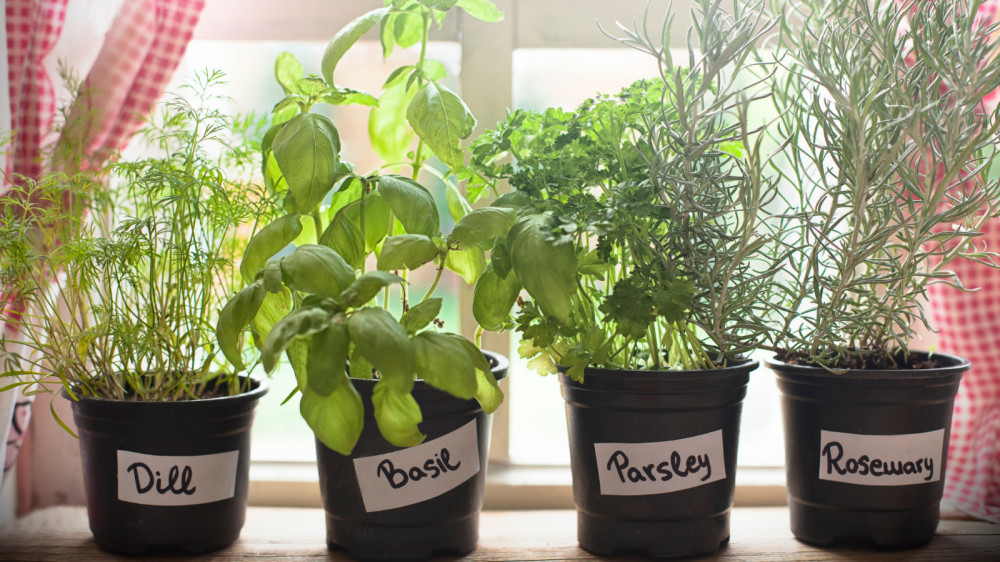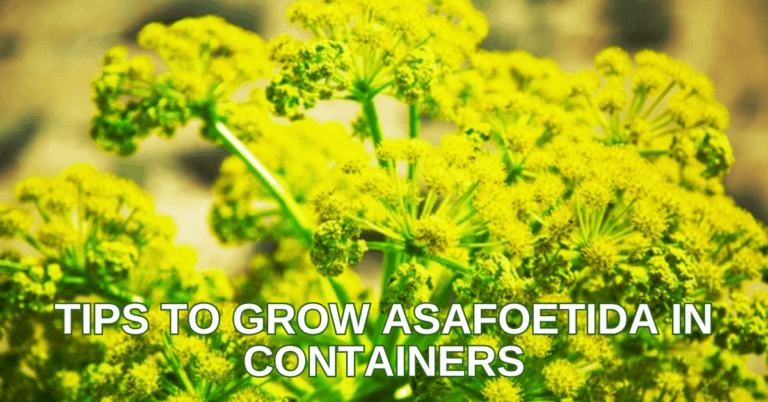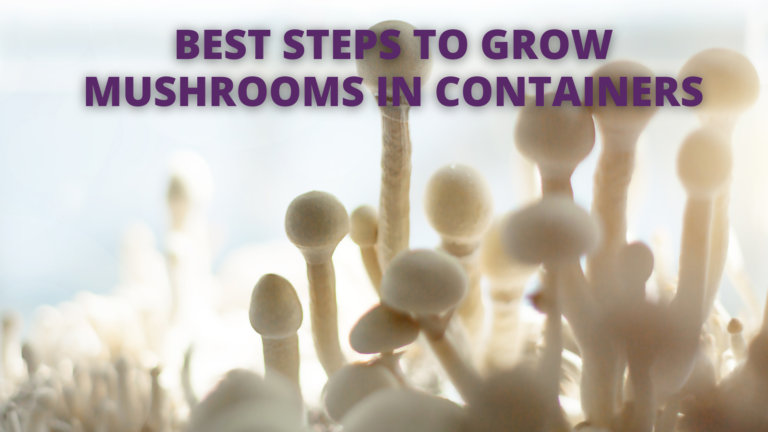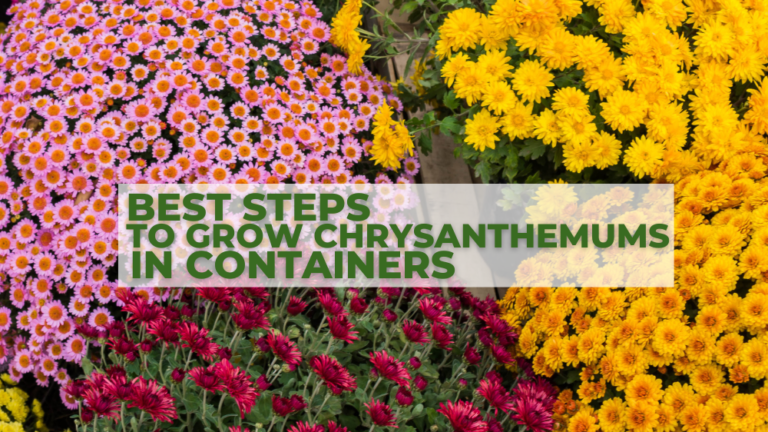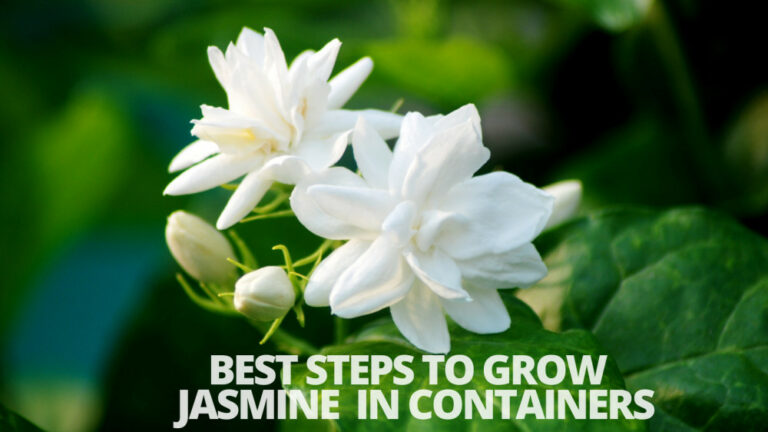Best Tips To Growing Herbs In Containers
Best Tips To Growing Herbs In Containers
You can use nearly anything as a herb container if it has proper drainage. You may use tiny pots because most herbs do not have extensive root systems. This is especially true for herbs that prefer to dry out between waterings.
However, the less soil there is, the smaller the container. This implies you have a narrower margin of error when using too much or too little water. I hope these tips will help you to grow herbs in containers ideally.
1. Choose The Right Site
One of the most pleasing aspects of container gardens is their portability. Aside from the genuinely jumbo-sized pots, you can lift, move, and rearrange them to ensure that they have ideal growth conditions all year.
If desired, place some near the kitchen for easy access. They look great grouped on the deck, doorsteps, edging paths, patios, and window boxes. They can be placed anywhere to enjoy their beauty and scent.
However, not all have the same growth circumstances. Some herbs thrive in dry, scorching climates, while others prefer a moist and shady environment.
They should all get at least six hours of sunshine daily. Additionally, position your pots according to the specific requirements of each plant.
Additionally, herbs with similar growth requirements should be mixed in the same container. You should also place your pots near a water supply. Containers dry up considerably faster than plants in the ground, and drought-resistant plants must be watered regularly.
Consider utilizing a drip watering line if you have many pots. They're cheap, simple to install, and unobtrusive. They also help reduce water use.
2. Choose The Right Container
Containers must be large enough to accommodate the roots and provide sufficient support for your plant. A decent rule of thumb is to select pots that are at least one-third of the mature plant's height and half to three-quarters of its mature width.
For example, a low-growing plant like common thyme grows to 12 inches tall with an 8-inch spread. Container-grown thyme should have a minimum pot size of 4 inches tall by 4 to 6 inches wide.
However, larger plants are generally preferable, such as lemongrass, rosemary, or sage. The pot height for large specimens should be closer to one-half of the mature height.
Additionally, larger pots provide better protection from cold temperatures, especially when you need to shield plants from winter weather. Whatever size you choose must include drainage holes to allow water to drain away from the roots.
One of the primary reasons for plant failure in containers is root rot, which is easily introduced when plants have “wet feet,” meaning their roots are left standing in water or oversaturated soil for prolonged periods.
I also recommend covering the drainage holes with a layer of material to prevent the soil from becoming soggy. Coconut coir, stones, broken pottery, and other similar materials can all be used to aid in draining excess water.
Containers are often constructed of ceramic, metal, plastic, resin, terra cotta, or wood. The material you select is a matter of personal preference.
However, plastic or resin is the most excellent choice for overwintering since they are less prone to be harmed by the cold. They're also the lightest to transport.
3. Water Requirements For Growing Herbs In Containers
Whether deciding when to water potted plants, I nearly always raise the container (or at least one side) and weigh it. This seems much more accurate to me than feeling the soil.
Perhaps it's just my fingers, but I can't tell how dry the soil is by feeling it. This is the next best option if you can't raise your container readily.
When you get to know your plants, you'll notice that certain leafy varieties exhibit “pre-wilt,” when the soil is really dry, but the plant hasn't yet begun to wilt.
The leaves and stems appear somewhat lowered without being wilted, which is the best way I can describe it (droopy is too strong a term).
If you have a basil plant in the kitchen, you may notice it if you forget to water it, and you'll know it's time to reach for the watering can.
Herbs can also be cultivated indoors, near a sunny window. They may get leggy and require more frequent replacement, but they are still less expensive than buying chopped herbs at the shop, providing greenery to your decor.
4. Soil Requirements For Growing Herbs
Select an all-purpose, packaged planting material. It's doubtful that you'll need to add more perlite, sand, or other amendments to make it lighter.
It should already be light enough if it's a decent container planting mix. Pots already dry up rapidly, and most herbs require a consistent supply of accessible water, especially when planted in a planter rather than in the ground.
You can cover the drainage hole with mesh or a curved piece of broken pottery to prevent soil and roots from clogging it.
Keep a few curved pieces of broken pots on hand to cover drain holes and prevent roots from clogging. Use the same potting soil instead of adding pebbles or rocks to the bottom for drainage.
5. Fertilizer
Many herbs have a short life cycle, lasting only a season, whether grown indoors or outdoors. Plants like basil, parsley, and cilantro blossom, set seed, and then die. Their life periods are short, ranging from 45 days to 4 months, depending on species and environment.
Woody or semi-woody varieties, such as rosemary, sage, and lavender, will live for years, so fertilize them to stimulate growth and flowering. Others, such as mint, thyme, and oregano, are spread by runners and continue to grow endlessly.
Again, only a small amount of fertilizer is required. I believe mint would outlive cockroaches in the event of a nuclear catastrophe.
Mint can be highly invasive, so keep it confined to a separate pot to prevent it from outcompeting the other plants, unless you don't mind going wild (or you make a lot of mojitos).
6. Overwintering Herbs In Containers
Some herbs, such as French tarragon and mint, die back in the winter. Most herbs, including these, will care for themselves if they are not chilled, wet by rain, or allowed to dry out.
Suitable locations include rain shadows on walls, cold frames, and open-faced sheds. A sheet of glass or plywood can deflect heavy rain in damp areas.
Cover containers with bubble polythene to keep them from freezing if freezing weather is expected. Some sensitive herbs, such as basil, can only be cultivated indoors in a warm, well-lit, frost-free greenhouse, conservatory, or sunny windowsill.
7. Pruning Herbs
Annual herbs don't need to be pruned, and herbaceous plants can be trimmed in late fall. On the other hand, your woody perennials require yearly trimming to maintain their form and size, and to enable the creation of new leaves.
Once they have gotten overrun, restoring them to a compact, neat form isn't easy since the woody stems will not develop new growth. When you cut them at this time, you get stubby sticks with no foliage.
Pruning woody plants like bay, lavender, rosemary, sage, and thyme is best done in early spring, just as new growth develops at the base of plants or on their lowest branches.
Have you missed this opportunity? The next optimal time is immediately after the plant has finished blooming. Reduce branches by one-third, cutting slightly above a group of leaves. Remove any wasted flowers and flower stems.
Late in the season, avoid pruning woody perennials. This promotes new growth when plants should be preparing for hibernation.
Tender branches are readily damaged by winter cold, which can weaken and kill plants. Trim sparingly as needed during the growing season, selecting outer stems and snipping them to maintain a clean shape.
Best Herbs For Containers
1. Mint
Consider mint if you're seeking perennial herbs in pots. I first became acquainted with mint when I planted a few sprigs in my mother's perennial garden.
After twenty years, it soon took over, and we're still digging it out! Sorry about it, Mom. Mint is now grown in pots, where its rapid growth may be controlled.
There are numerous distinct types of mint, including peppermint, chocolate mint, mojito mint, strawberry mint, and spearmint, which I enjoy growing in a large pot.
We use the leaves in summer beverages and fruit salads and dry them for winter tea. Mint prefers wet soil and rich soil. In my mint planters, I add two-thirds potting mix and one-third compost.
2. Oregano
Oregano leaves become more flavourful as they absorb more sunlight. Oregano is drought-resistant and grows best in well-drained soil. This essential herb for spaghetti sauce requires excellent drainage and will not thrive in moist soil.
3. Cilantro
Cilantro, often known as coriander, blooms quickly. That implies you should seed it between August and September when it will be less prone to bolting.
Cilantro is one of the few herbs that can benefit from shade to discourage it from blossoming too soon, but it also grows well in full sun.
Keeping cilantro adequately hydrated and nourished will also help keep it from bolting too soon. Whatever you do, your cilantro plants will ultimately blossom. Fortunately, its blossoms attract hoverflies, which devour aphids, so cilantro farmers win in both cases.
4. Rosemary
Rosemary grows well in full sun and well-drained soil. This plant dislikes damp roots, so ensure sufficient drainage and avoid overwatering.
Rosemary prefers hot, dry, and sunny circumstances and grows in USDA zones 7-10. Its fresh, crisp flavour makes it a must-have herb for Mediterranean cooking.
5. Basil
Provide basil plants with ample sunlight and warmth. This plant requires well-draining soil to keep its roots dry. Drink water once a day, especially in the morning, before exposure to sunlight.
Basil is a common ingredient in Italian cooking and comes in various flavours. When growing basil with other herbs, use big, five-gallon pots, or try growing more compact kinds in smaller containers.
>>> Please click here for my blog post on Healthy Vegan Recipes Using Basil <<<
6. Sage
Sage plants require ample sunlight and well-draining soil. Like rosemary and thyme, Sage will suffer if its roots are consistently damp.
Therefore, appropriate drainage is essential. Most types are hardy in USDA zones 4 through 10. Sage is an excellent spice for chicken meals in the kitchen.
7. Parsley
Parsley will produce for two years once planted, before flowering and dying. This traditional seasoning plant takes some time to get started, but it produces a large number of new leaves once it does.
It prefers more water than other herbs and is one of the few that can benefit from a bit of fertilizer. Each year, a light feeding of a slow-release organic fertilizer should be applied to the soil in early spring.
>>> Please click here for my blog post on Healthy Vegan Recipes Using Parsley <<<
8. Thyme
Give thyme plenty of sunlight and well-draining soil to help it thrive. Thyme, like rosemary, cannot tolerate damp roots; therefore, ensure proper drainage and avoid overwatering your plants. Thyme grows well in USDA zones 4 through 10.
>>> Please click here for my blog post on Healthy Vegan Recipes Using Thyme <<<
9. Chives
Chives require at least five hours of direct sunshine daily and wet soil conditions. In chive pots, avoid allowing the soil to dry out.
This plant requires organic matter-rich soil. Chives grown in pots are hardy in USDA zones 3-10 and can be left outside all year.
Chives are similar to onions in terms of culinary uses. They have a robust flavour and aroma. Use them as a garnish or in salads, soups, and baked potatoes. Even the blooms are edible and delicious.
>>> Please click here to find my blog post on the 6 Most Popular Vegan Recipes Using Chives <<<
10. Lemon Balm
Lemon balm, a mint relative, exhibits the same aggressive growth tendency as mint and can quickly take over small garden spaces. As a result, I grow lemon balm in pots.
It's a hardy perennial in zone 5 and can even overwinter in containers. Water it frequently, using the same soil mixture (potting soil and compost) as you would for mint.
For the most delicate flavour, it requires enough moisture. What a taste! Lemon balm has a lemony, minty scent and flavour, accompanied by its shiny green foliage. It tastes delicious in fruit salads, tea, lemonade, and marinades.
>>> Please click here to find my blog post on the 9 Delicious Vegan Recipes Using Lemon Balm <<<
Mistakes To Avoid When Growing Herbs In Containers
1. Incompatible Herbs Grown Together
Check the light, temperature, and water needs of the herbs you intend to cultivate and plant them with like. Planting drought-tolerant rosemary and moisture-loving mint in the same container is not a wise idea since both will suffer from the watering schedule of the other.
The same applies to other care considerations, and you should conduct a thorough study before combining herbs.
Furthermore, herbs, like many fruits and vegetables, have partner plants with whom they grow well and ‘enemies' with whom they will not share a pot. For example, herbs of the mint family do not grow well when planted with chamomile or parsley.
2. Allowing Herbs To Go To Seed
Most common garden herbs are collected for their aromatic leaves and stems. While many contain edible flowers and seeds, allowing them to expend their energy on flower production, seed development substantially reduces the quality of the leaves.
To maintain beneficial herbs for as long as possible, prevent them from ‘bolting,' which is the process by which plants begin to focus on flower and seed development.
3. Overcrowding Herbs
Take care not to plant your herbs too tightly. Remember that they will develop and expand rapidly!
Many herb gardeners may plant multiple herbs in one pot or window box, and many of them grow well together, repelling insects with their intense aromas.
It's easy to underestimate how big your herbs will grow when you plant them as seeds or transplants, since many will expand to fit the area you provide them.
Too many herbs in one pot can result in resource rivalry, inadequate ventilation, and an increased risk of illness among your plants.
4. Purchasing Diseased Or Sick Herb Plants
Before purchasing young herbs, research and seek labels that indicate the plants originated from a sterile environment.
Several herbs, especially woody herbs like rosemary, sage, and lavender, are challenging to grow from seed, and it might take many years before they are mature enough to provide a crop.
As a result, most gardeners will buy these herbs as transplants from nurseries, neighbours, or plant centers to utilize that season or the following year.
Always buy from recognized and trustworthy merchants. Otherwise, you may end up with infected herbs that quickly spread disease-causing germs throughout your container garden, ultimately harming all your herbs.
Conclusion
If you cultivate primarily for culinary purposes, nothing beats having a plentiful supply of fresh herbs. If you're new to gardening and want to start with a basic container garden that allows you to produce fresh herbs for cooking, you're in luck.
Fresh herbs are straightforward to cultivate, and beginning your herb garden in pots is an excellent way for newbies to get their hands dirty.
Herb container gardens are not only one of the most specific gardening projects to begin, but they also have a high success rate. I know you will successfully grow herbs in containers if you follow my tips.
I trust you enjoyed this article on the Best Tips To Growing Herbs In Containers. Please stay tuned for more blog posts to come shortly. Take care!
JeannetteZ
>>> Please click here to read my all-inclusive article about Container Gardening <<<
>>> Are you interested in homegrown herbs and medicine? Please click here to find out more about it! <<<
Your Opinion Is Important To Me
Do you have thoughts, ideas, or questions? I would love to hear from you. Please leave me your questions, experiences, and remarks about this article on the Best Tips To Growing Herbs In Containers in the comments section below. You can also email me at Jeannette@Close-To-Nature.org.
Disclosure
This post may contain affiliate links. I earn from qualifying purchases as an Amazon Associate and through other affiliate programs. Please read my full affiliate disclosure.
You might also enjoy these blog posts:
Best DIY Natural Beauty Tips For Glowing Skin
Best Persian Cat Health Care Tips
Easy Steps Of Growing Plums In Containers
Easy Ways To Grow Broccoli In Containers

